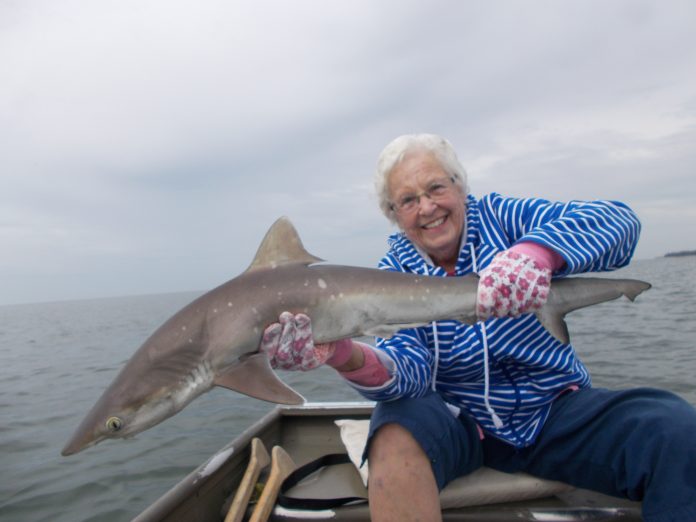It was another rainy week in the Tampa Bay Region, but anglers enjoying the cooler temperatures caused by the cloud cover (and avoiding the downpours) still had plenty of action at the Sunshine Skyway Fishing Piers. Mangrove snapper were on a good bite for anglers fishing the best tides & structure at the best times. Gag grouper remain very active, but this week saw anglers catching larger numbers of short fish for each keeper taken. Spanish mackerel were around at times and picked-up remarkably late in the week as they gorged themselves on the massive schools of fry that were around the piers this past week. Small sharks – especially sharpnose – are providing great entertainment value for visitors from locations near & far seeking their first toothy critter. Blue crab netting is still going good on the North Pier during outgoing tides and many big shrimp are being picked-up by folks who look for those glowing eyes!
Baitfish activity around the piers this past week was mostly at two extremes – very large 6″+ threadfins – or very small 1″ – 2″ young-of-the-year sardines, herring and anchovies. Many folks locally call all bay fry ‘glass minnows’ at the early stages of development, but the anchovies are really the species you can actually see through… Scaled sardines in the medium size class (that so many anglers favor) were difficult to procure – even for the salty dogs who make their living catching these fish. Threadfins are great fished whole for large predators like grouper, cobia, tarpon and smaller sharks – but they are somewhat difficult to keep alive in a bait well or bucket – making their immediate deployment for live bait fishing important. Kept on ice in a plastic bag, threads are great cut bait for a variety of species – including mangrove snapper. Threadfins are softer (and oilier) than sardines, so they will often attract other fish to the area. Other than keeping them as cold as possible, one other trick is to cut the chunk to almost exactly fit your hook. When hooked properly you will not even seek the hook – only the eye. Fry or glass minnows of many species can be frustrating for bait fishers because they will often foul in the commonly thrown 3/8″ mesh cast nets. Throwing a 1/4″ mesh net will allow you to procure hundreds of these ‘snapper candies’ that can be threaded onto a hook in 1’s or 2’s – just like earthworms for bluegills.
Spanish mackerel showed in low numbers early in the week, progressed through the week and by Friday afternoon there were groups of 2 or 3 anglers that had 15 or more legal length fish in the cooler. Thursday in the late afternoon showed a bite high in the water column as visitors were fishing both silver spoons and Gotcha lures near the surface – either ‘naked’ by burning the retrieve – or with the assistance of a popping cork. On Friday morning, anglers in the area of the South Pier Bait Shop were connecting with nice mackerel on spoons fished behind a trolling sinker. Aluminum-bodied silver spoons dramatically outperformed the nickel-coated steal or brass variety – perhaps because their lighter weight & more pronounced flutter allowed them to be more easily mistaken for the flash made by the schools of glass minnow the macks were crashing. Experienced pier anglers know that on a great mackerel bite they will hit almost anything. However, when mackerel are neutral to negative, the minor adjustments separate a full cooler from an empty one. In this case, the reporting anglers praised the aluminum-bodied silver spoons.
Mangrove snapper remained good at night and some nice fish were also taken during daylight hours. Although most of the seasoned mango hunters at the piers only fish after darkness falls, plenty of fish are also taken in the “darkness” available in broad daylight. There are shadow lines at the piers during every minute of the day and these include main bridge pilings, closed pier span pilings and the area directly under the pier itself. Fishing pure shade & shadow lines during the day is a great way to connect not only with mangrove snapper, but also the occasional snook or spotted trout. Many nice snapper limits were taken by anglers fishing the artificial reefs after dark this week, with the folks willing to take the time to get a dozen or so nice scaled sardines on ice for cut bait during the daylight hours cashing in on almost every chunk. Some nice grunts, flounder and lane snapper joined the mix – as did plenty of short gag grouper.
Sharpnose sharks have been around in great numbers for several months now, but the action this past week was exceptional. Many new saltwater anglers caught their first shark this week and the sharpnose were the main culprits. This shark species is prominent in the Tampa Bay Estuary and does somewhat slightly change in appearance as it matures. Young sharpnose sharks almost always have plenty of attractive white polka-dot-like spots along each side of their body. As the fish grows, these spots either diminish or disappear entirely. Obviously the pointed nose of this species is a telltale identification sign, but the Florida Fish & Wildlife Conservation Commission (FWC) has handy shark identification pictures both online and in printed materials. The sharpnose shark is an excellent eating species, whether grilled, broiled, sautéed or deep fried. As with all shark species, the fish should be bled upon catching and kept on ice until final culinary preparations are undertaken.
- The Skyway, Paul Bristow - August 24, 2018
- The Skyway, Paul Bristow - August 17, 2018
- The Skyway, Paul Bristow - August 10, 2018











